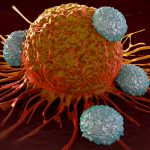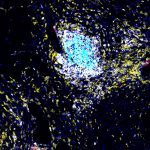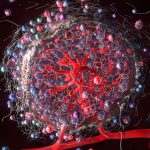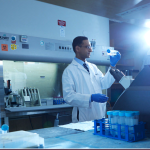When T cells, the immune system’s chief cancer-killing agents, are working overtime to battle a tumor, they can enter a state of exhaustion where they no longer function properly. In a new Nature Immunology study, University of Pittsburgh and UPMC Hillman Cancer Center researchers report that the low oxygen environment of tumors can prompt these tired T cells to switch allegiance so that they suppress the immune system instead of combating cancer.

“We often think about our immune system in absolutes: Certain types of cells are ‘good’ and some are ‘bad,’” said senior author Greg Delgoffe, Ph.D., associate professor of immunology at Pitt’s School of Medicine and director of the Tumor Microenvironment Center at UPMC Hillman Cancer Center. “The key takeaway from our work is that our immune system is critically sensitive to its local environment. In the right environment, cells typically thought to be anti-cancer can switch sides and work against us.”
The new study, which was led by Paolo Vignali, Ph.D., a student in Pitt’s Medical Scientist Training Program, also showed that targeting low oxygen levels reduced the suppressive nature of exhausted T cells and improved response to immunotherapy.
Delgoffe and Vignali elaborated on the study’s findings and how they could inform the next steps of developing therapies.
What are exhausted T cells and what role do they play in cancer and other diseases?
GD: Exhausted T cells are the soldiers of our immune system that have been fighting their battle with cancer constantly and without rest. Our immune system uses T cells to find and kill abnormal cells, such as those that are cancerous or virally infected, and they are built to continue fighting until every abnormal cell is removed. But in diseases like cancer, where cancerous cells keep pace with the immune system, T cells can fail at their job, and abnormal cells stick around. As T cells keep fighting these cancerous cells, they get progressively worse and worse at their job.
PV: Exhausted T cells are an adaptive response to too much “signal.” These signals can come from pathologic sources, such as a cancer or a virus, but they also arise in healthy tissue, so we find exhausted T cells in autoimmune disease, where the immune system inappropriately attacks the host, and in the placenta where the mother’s immune system adapts to the growing fetus. In these settings, T cell exhaustion is a good thing: It helps control unwanted damage by activated T cells.
What did you learn about exhausted T cells in this new study?
GD: As exhausted T cells no longer do their job of killing cancer cells well, they have become the target of immune-based therapies for cancer. The idea is that if we can reinvigorate them, they will effectively kill cancer cells again. What we learned in our study is that when exhausted T cells enter tumors, they do not just become less functional themselves; they actually change the environment around them to actively turn off other cells nearby. In other words, exhausted T cells aren’t just failing to work for us; they are actively working against us.
PV: The idea that exhausted T cells are working against us in cancer opens up new avenues for immunotherapy, such as developing treatments to target the pathway responsible for switching sides or engineering better T cells for cell-based therapies. While the immunotherapy field has rightfully been focused on correcting T cell loss of anti-cancer functions, our efforts show we should also be studying potential new behaviors gained by these cells.
Were you surprised by any of the results?
GD: Exhausted T cells bear a lot of similarities to regulatory T cells, a type of T cell that helps the immune system control itself to prevent autoimmune conditions. We found that exhausted T cells functionally mimic regulatory T cells by suppressing the immune system. We had some hints about this finding, so this wasn’t too surprising. However, we were surprised to find that exhausted T cells’ immunosuppressive function was tied to the environment in which we studied them. In short, we found that more aggressive tumors tended to have more immunosuppressive exhausted T cells, while tumors that grow more slowly had exhausted T cells that were simply less functional — but not suppressive.
What do your findings suggest about therapies to target exhausted T cells?
GD: The observation that the local tumor environment dictated whether or not exhausted T cells were immunosuppressive was a clue. It told us that if we could reprogram or modulate the local environment, perhaps the suppressive nature of these cells could be reversed. And that turned out to be the case: We used drugs that do not specifically target T cells but rather change the battlefield they are fighting on by targeting tumor vasculature and metabolism. We found that making conditions more favorable was enough to get exhausted T cells within these treated tumors to temper those anti-inflammatory functions, which improved tumor response to several immune-based cancer therapies.
PV: The finding that we could reverse anti-inflammatory functions in exhausted T cells is particularly exciting. Many large, sophisticated studies have taught us that most features of exhausted T cells are irreversible — they are stuck being poor tumor killers. However, the battle between the immune system and cancer is a delicate balancing act. Here, our data show that we can target the battlefield and shift the balance in favor of immune cells, even in large aggressive tumors.
What are the next steps for this research?
GD: We are currently running several clinical trials in Pittsburgh using these environment-modulating drugs in cancer patients. The next big question will be whether we can reverse the immunosuppressive character of exhausted T cells in these patients. We’re also interested in developing drugs that directly target T cells’ suppressive character in patients. Beyond cancer, exhausted T cells also appear in chronic infections like hepatitis and HIV, autoimmune diseases such as lupus and Type 1 diabetes, and in the gut. Discovering the role for these cells and their suppressive character in other contexts will be a new direction for this research.









